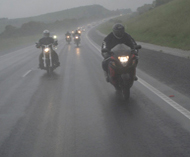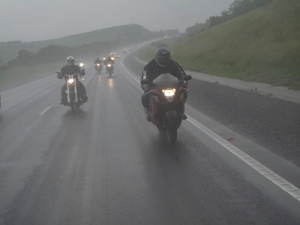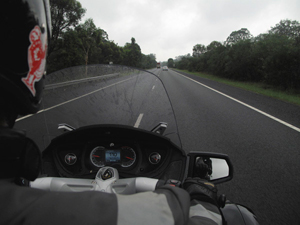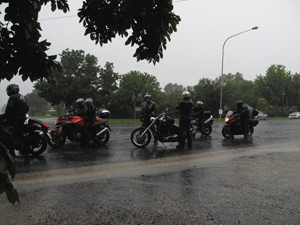
Slip slidin’away
Stuart Woodbury’s wet-weather wisdom
PHOTOS: Nick Wood 
As I sit here on a rainy day singing to my kids, “Rain, rain, go away, come again another day,” it got me thinking of how I used to hate riding in the rain — one, because it meant so much work cleaning my bike to make it look showroom again and two, I just didn’t have the enthusiasm to get cold and have gear that leaked occasionally. There’s nothing worse than being wet while riding.
I did, however, make a promise to myself and that was to do whatever was necessary to sort out my wet-weather riding. It didn’t happen overnight, but gradually over the years I’ve come to enjoy the challenge.
Be a boy/girl scout
Being prepared is the key and being warm and dry is essential. So when I’m setting off for a relatively short ride, I first of all check the weather bureau and if there’s rain on its way I take my trusted Alpinestars backpack housing my trusty Alpinestars wet-weather pants and jacket — and when I say trusty, I mean they have never leaked, even in some of the heaviest “Why am I even riding in this?” downpours.
If I’m going away for a longer trip, the gear goes into an easily accessible area where I can get to it ASAP when the rain starts falling. I also pack according to the season to add some layers underneath if need be. Keeping warm in the rain will make the experience so much better and allow you to concentrate on your riding.
Don’t take air out
Modern road tyres give fantastic performance in the rain and they work even better with some temperature in them. Although it’s harder to get heat into the tyres in the rain, go easy for the first few kilometres to help raise them up nicely. But apart from checking tyre pressures there is nothing I would change from a good dry riding setup — not that you’ll really have time (or care) to do anything by the side of the road, anyway!
I’ve heard of some riders reducing tyre pressures for the wet as they believe that it gives better grip and will allow the tyre to heat up more. I totally disagree, as this will only let the tread “fold” in and reduce water displacement as the manufacturer of the tyre has designed. Standard recommended pressures are best and there is always a chance the roads might dry up, so regular suspension settings are also best.
Go soft
If you’re certain you’re going to be riding in wet conditions for some time and you really must play with the suspension settings, first of all, record what you had the settings on and look at taking three clicks off the front and rear compression and rebound adjusters, plus 2mm off the front and rear preload adjustment. If the adjusters don’t click but turn, I would reduce them by three turns. This softens the suspension, giving more weight transfer, and should increase tyre temperatures.
Use two fingers 
The first change you could do to help you lose the fear of locking the front brake is to use one or two fingers on the front brake in wet conditions. Doing this makes it harder to lock up the front wheel. In dry conditions I normally only use two fingers, so if you use three or four fingers in the dry try to reduce your grip by at least one finger. The danger zone while braking is the first moment before weight is transferred onto the front suspension, so it’s very important to be gentle during initial braking in the wet. Squeeze the lever like you have an egg shell under it.
With this in mind, begin the braking process with changing down a gear or two as it gently helps to get the weight transferred to the front tyre. Use extra engine braking by down-shifting earlier in the wet (just don’t pop out the clutch fast) as it’s much safer than relying purely on the front brake to wash off speed. Once the front tyre is loaded then it’s OK to increase pressure on the brake lever to slow things up. It’s still OK to use the rear brake but I find it hasn’t as much feel in wet conditions. No matter if you are braking or accelerating, if the rear locks or spins up, providing you keep the bike upright you are unlikely to get into trouble.
The tyre’s contact patch is at its optimum when you are fully upright, so ideally you need to be completely off the brakes before leaning in. This is why I like engine braking as you can quite often control everything with the throttle and avoid touching the brakes. As most road surfaces are cambered, the least amount of water tends to be in the middle, so I like to ride just to the inside of the white line. You’ll also notice this is where the road starts to dry out first so this is where the best grip is most of the time. I also look for the dry spots: anything shiny will normally mean the road is very wet or there is some oil on the surface.
Be an upright citizen
The same rule of keeping upright for maximum grip applies on corner exits. I never get anywhere near a full open throttle until I am bolt upright. However, if I’m pushing hard I’ll hang off the side of the bike and have the bike bolt upright to get the power down early.
This principle can work at any speed. Try rolling in neutral down a slight hill, keep the bike dead upright and lean off the side. What happens? Yes, the bike turns in the direction you lean. So practise it as you ride and it will give you more grip in the rain, by keeping the bike in that meatier centre patch of the tyre.
Go tall
I will always use a tall gear with low revs mid-corner and then, when I’m at the corner exit, I find short-shifting or changing up through the gears just before the engine starts to pull hard is the safest and most efficient way to build up speed. It may feel slow, but this delivers the most grip, giving good control while keeping the bike nicely balanced. 
Do it easy
If you do have to cross any white paint, drains or cat’s eyes, do it with a neutral throttle (not fully on or off) and if you need to brake over the same hazards just ease off the pressure momentarily until you are back on bitumen again.
Be a smoothie
My final tip is to try to stay smooth and relax. Riding in the rain needs a lot less physical effort so, while you must keep your wits about you, being less tense is important. So long as accelerating, braking and changing direction are all done in a gradual, steady manner you’ll get plenty of warning before you get into bother.
SW
SIDEBAR
Things to remember in the rain – repeat after us
• Wear the proper gear. You’ll always hate it if you feel cold and have a wet crotch.
• Try using fewer fingers on the front brake. You need a lot less pressure in the wet compared to the dry.
• Change down early and use the engine for rear braking.
• Stay upright until braking is totally finished.
• Coast through corners in tall gears and once upright short shift during hard acceleration.
• Keep the bike more upright on the centre contact patch of the tyre.
• Soften your suspension (if you must).
• Relax and stay smooth for better all-round feel.
